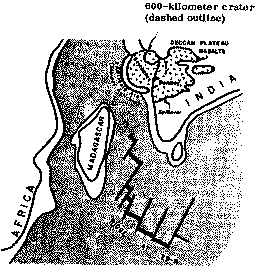 |
Science Frontiers ONLINE No. 61: Jan-Feb 1989 |
|
|
Terrestrial maria?
Those dark patches that constitute the face of the man-in-the-moon are really huge outpourings of lava. Once considered real seas, they are called "maria." Maria like those on the moon also exist on the earth. This is a surprise because terrestrial maria were never mentioned in my college geology courses. But, in those days, the one-mile-wide Meteor Crater, in Arizona, was the largest accepted consequence of celestial bombardment.
 Deccan basalt flows (also called the Deccan traps) in Western India, shown before the formation of the Carlsberg Ridge and teh splitting off of the the Seychelles. |
D. Alt and colleagues, at the University of Montana, have identified four large basalt plateaus that might be terrestrial maria:
"Notable examples of large lava plateaus that resemble lunar maria include, among others, the Deccan Plateau of India, the Columbia Plateau of western North America, the Parana Plateau of South America, and the Tungusska Basin of Siberia. All consist mostly of basalt lava flows; those on continents include minor quantities of rhyolite, and variable amounts of sediment. All seem to have appeared suddenly, within plates. No consistent context of plate interactions explains them. We suggest that large lava plateaus are indeed terrestrial maria."
Alt et al go on to show that these lava plateaus seem to have initiated continental rifts and hotspot tracks where none existed before. A reasonable inference is that these plateaus are the consequence of the impacts of large meteorites. This is particularly the case with the Deccan Plateau, which is agedated as synchronous with the Cretaceous-Tertiary Boundary event, with its legacy of worldwide iridium deposits and the wholesale extinction of life. The paper concludes with:
"It therefore appears that random encounters with vagrant asteroidal objects play an important role in setting the course of plate tectonic events. The earth does not control its own agenda."
(Alt, D., et al; "Terrestrial Maria: The Origins of Large Basalt Plateaus, Hotspot Tracks and Spreading Ridges," Journal of Geology, 96:647, 1988.)